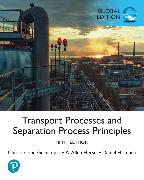KlappentextToday, chemical engineering students need a thorough understanding of momentum, heat, mass transfer, and separation processes. Transport Processes and Separation Process Principles, 5th Edition offers a unified and up-to-date treatment of all these topics. Thoroughly updated to reflect the field's latest methods and software technologies, it covers both fundamental principles and practical applications.
ZusammenfassungThe Complete, Unified, Up-to-Date Guide to Transport and SeparationFully Updated for Today's Methods and Software Tools
Transport Processes and Separation Process Principles, 5th Edition, offers a unified and up-to-date treatment of momentum, heat, and mass transfer and separations processes. This editionreorganized and modularized for better readability and to align with modern chemical engineering curriculacovers both fundamental principles and practical applications, and is a key resource for chemical engineering students and professionals alike.

